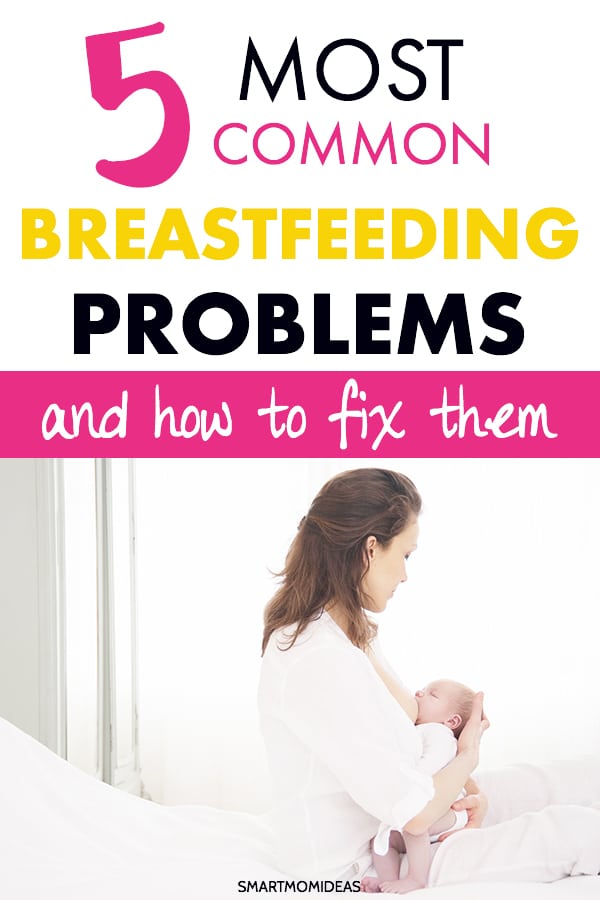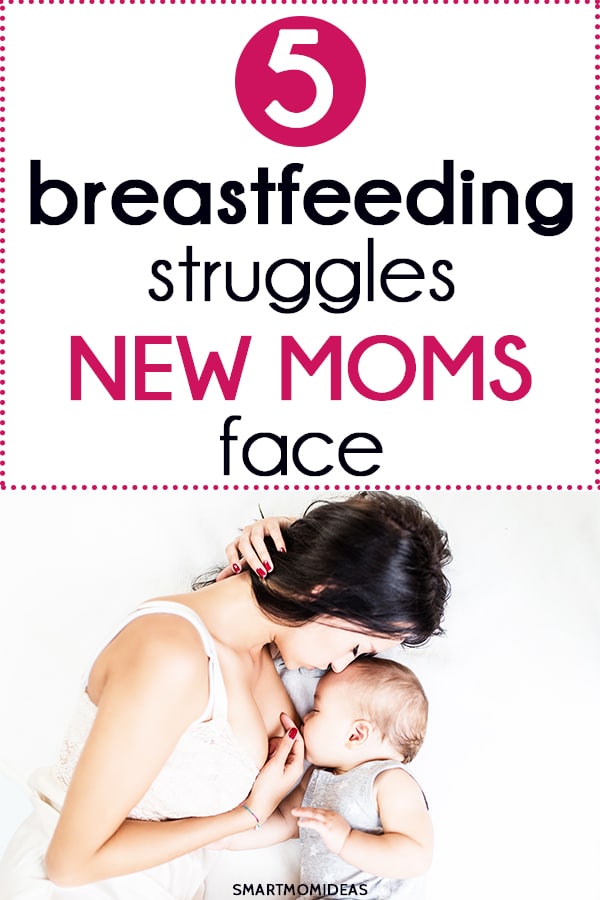New breastfeeding mom? Learn the most common breastfeeding problems and how to fix them easily!

Breastfeeding is natural.
But it’s NOT always easy, right, mama?
For me, as a mom to twins I struggled with breastfeeding.
In the end, my daughter continued to breastfeed past one years old, but my son started to prefer the bottle and didn’t do much breastfeeding past six months.
If you’re a new mom struggling with breastfeeding, believe me, you’re not alone.
There are so many things that make breastfeeding really tough!
But with a bit of support and practical advice, it’s possible to get over most hurdles and actually enjoy breastfeeding – and, mama, your children will be weaned before you know it!
Breastfeeding Twins
While I was pregnant I decided that I wanted to exclusively breastfeed my twins because breast milk is the natural choice for babies and it’s free, right? Double win!!
But of course when it comes to kids, nothing quite goes to plan!
And no matter what I did, I just didn’t have enough milk for two babies so I had to supplement. At first we used donor milk, which is a great choice, but also pricey – and the cost of twins is no joke!
So my husband and I switched our twins to formula and fed them 60% breast and 40% formula. And we did that for over a year.
I basically had enough milk for one baby.
Looking back I’m thrilled I was able to breastfeed and I’m certainly not beating myself up because my plan to exclusively breastfeed didn’t work out.
So I’ve rounded up 5 of the most common breastfeeding problems for new moms along with some simple, easy to try solutions.
CAVEAT If you’re worried about your baby gaining weight or any other medical issue, please see an appropriate medical professional immediately. I’m not a lactation specialist but I’m sharing tips that worked for me and lots of other moms. Please remember that every mom and baby is different and these tips may not work for you.
5 Breastfeeding Problems All New Moms Struggle With

1. Low Milk supply
Let’s start with a big one, mama! Is your baby getting enough milk? All new moms struggle with this one – I know I did!
How do you know if your baby is getting enough milk?
There are two things to track here:
How many wet diapers does your baby produce each day? Track these using a handy app or try a bullet journal – you’re too tired and busy to simply remember how many diapers you change every day!! And Ray from Stork Mama has a helpful chart about how many diapers baby should be producing according to baby’s age.
How much weight is baby gaining? It’s normal for babies to lose a little bit of weight after they’re born – even up to 10%. But keeping track of baby’s weight gain is vital for checking if baby is getting enough milk.
Be sure to attend those recommended weigh-ins and you could even invest into your own set of baby scales. A set of baby scales can be converted into regular scales so you’ll be using them for years!
What to do about a low milk supply?
It’s important to speak to your doctor or other appropriate medical professional if you’re worried about baby getting enough milk. But there are a couple of simple, easy ways to boost your milk supply.
1. Lactation Smoothies
Probably the simplest – and most delicious – way to boost your milk supply, is with a lactation smoothie. Check out this list of 15 lactation smoothies.
2. Feed on Demand
I know the on demand vs scheduled feed debate is controversial. But milk supply depends on how often your breasts are emptied. And feeding on demand lets your body know how much milk to produce to satisfy your baby.
3. Pump
Some moms find that extra pumping can help their milk supply too. You could pump the other breast while baby is feeding or pump when baby has finished breastfeeding.
Having a budget friendly electric pump is great for on the go. If you prefer a manual pump, it can also help you with your low milk supply as well. It’s more economical but is more hands on! And make sure you don’t waste a precious drop of breastmilk.
Catch any leaks with a milk saver.

And when you have your precious breast milk for your newborn, be sure to store and thaw your breast milk safely.
4. Take Care of Yourself
A breastfeeding mama needs nutritious meals. I know you won’t have much time or energy for cooking so why not try out an Instant Pot?
I got an Instant Pot last Christmas and it’s been a game changer. I’ve rounded up 25 vegan Instant Pot recipes to show how you can get a nutritious meal on the table double quick.
And don’t forget to stay hydrated. Keep a water bottle on hand to remind you to drink. I like the ones that holds up to 18 oz and keeps water cool for ages. Plus water is great for helping you lose that baby weight!
2. Poor Latch
Getting the perfect latch for breastfeeding is essential for making sure that baby gets enough milk and making sure mom doesn’t get sore nipples. Ouch!! But getting the perfect latch can take a LOT of trial and error.
You baby has a good latch if:
- Baby’s chin touches your breast
- Baby’s lips are curled outwards
- Baby’s mouth covers as much of your areola as possible
- Your nipples aren’t uncomfortable
- You can hear baby swallowing
- Baby is gaining weight
If you looking for some quick and easy ways to get the perfect breastfeeding latch, take a look at this helpful guide.
3. Confidence
Before I had my twins, I never really thought that breastfeeding could be difficult. I mean, you just stick your boob in baby’s mouth, right? Haha. But seriously, our expectations of breastfeeding can be very different to the reality.
And that can be a huge problem for mom’s confidence. So, here are a couple of breastfeeding truth bombs all new moms should hear:
- Breastfeeding can be exhausting – physically and mentally
- Babies like to cluster feed – and, yes, it’s exhausting
- Growth spurts mean that some weeks baby will feed much more – so get comfortable on the couch, mama.
- Breastfeeding hurdles can happen at any time – not just during the newborn stage.
- Your breastfeeding plans may have to change – it’s OK to supplement with donor milk or formula and that does NOT mean you’ve ‘failed.’
- Baby will be weaned before you know it!
Don’t let a lack of confidence ruin your breastfeeding hopes – ask for help when you’re struggling and talk to your husband about your worries. And don’t forget you will be breastfeeding in public! Here’s a guide on how to breastfeed in public without fear.
4. Breast Feeding Pain
Ouch!
Yes, breastfeeding can be painful sometimes. And for lots of different reasons. So here are some of the most common causes of breastfeeding pain.
CAVEAT: This list is not exhaustive and I’m NOT a medical professional, so seek appropriate help if you’re struggling with breastfeeding pain.
Sore Nipples
This can be worse in the early days of breastfeeding and luckily there are some quick fixes you can try.
- Make sure you get the perfect latch
- Try a breastfeeding pillow. The extra support can help you and baby find the best position for breastfeeding
- Use a nipple cream after feeding. This one is so soothing and you don’t have to worry about rinsing it one off before you feed baby again.
- Wear a high quality cotton bra
- Change breast pads frequently
Chat to your lactation consultant if you continue experiencing pain – nipple pain can be a symptom of a more serious problem.
Breast Engorgement
Mama, when you milk comes in during that first postpartum week, you’ll know it!
If you’re a B cup don’t be surprised if you find yourself suddenly a D cup – yes, really! And that sounds great. Except your boobs are rock hard, sore to touch and perhaps even lopsided! Yikes!!
Your body is still adjusting to how much milk your baby – or babies! – need. So breastfeeding on demand lets your body adjust naturally. If you’re still struggling you can hand express or pump off a little excess milk. Just don’t go overboard or your body may respond by making more milk!! The Medela Harmony Manual Breast Pump is a great budget option.
Mastitis
This is a nasty one, mama! Mastitis is an infection of your breast tissue. Symptoms of mastitis include:
- A hard lump in your breast
- Pain when breastfeeding
- Fever or flu like symptoms
- Nipple discharge
See an appropriate health care professional if you suspect mastitis – it can make you very sick if left untreated. Good latch, breast massage and frequently draining your breasts are important here. The Milk Meg has an awesome guide to treating and preventing mastitis.
Thrush
Thrush is a yeast infection that can make breastfeeding suddenly very painful. Common symptoms to look out for include:
- Irritation or swelling of your nipples
- Diaper rash
- White spots in your baby’s mouth
Here’s an awesome guide to thrush and how to deal with it.
And here’s how Sheena from Laptops and Naptimes survived thrush and continued breastfeeding.
5. Tongue Tie
A tongue tie happens when the skin linking baby’s tongue to the floor of the mouth is shorter than usual. And that’s a problem because it means baby can’t get a good latch. Some symptoms include:
- Baby seems to have difficulty staying on your breast
- Baby makes a clicking sound when they feed
- Baby not draining breast
- Baby not gaining weight
- Sore nipples for mom
But there are many more symptoms. Gabbie at Mom Makes Joy has a helpful guide. And The Realistic Mama shares her story of her baby’s tongue and lip tie.

Common Breastfeeding Problems for New Moms
Hopefully this guide to five breastfeeding problems for new moms will help you over a hurdle or two. Please remember to do what’s best for you and your baby!
That might mean breastfeeding exclusively, using formula or doing both! Don’t let your own expectations – or anyone else’s expectations overshadow those joyful moments with your new baby.
Don’t forget to pin for later!





Leave a Reply